We arrived in Marrakesh after a long, hot drive from Fes. Despite the comfort of the Mercedes van with our private guide and driver, we were tired and eager to settle down in the last destination of our trip in Morocco. The northern entrance to the city is not as magnificent as the one to Rabat, with its majestic palms swaying in the wind.
The Palmeraie’s grove of trees here have been decimated by a recent infestation and the six-month draught has also contributed to the ruined look. Soon, turned into the hassle and bustle of the Medina, the oldest part of town dating to the twelfth century—one of Mokhtar’s specialties is to date every single site.
The narrow streets were crowded with women shopping, children getting out of school—given the different shifts in public schools, there always seem to be youngsters, wearing their white dusters, running around—stray cats meandering about everywhere, and merchants eagerly peddling their wares. Bicycles and noisy motorcycles were swerving in and out of this mayhem. Next to a big cart full of butane bottles, our driver stopped announcing that this was as far as cars could go. Even before we had collected our growing assortment of shopping bags, a young man appeared with a rusty cart, gathered the suitcases and started running through the narrow streets.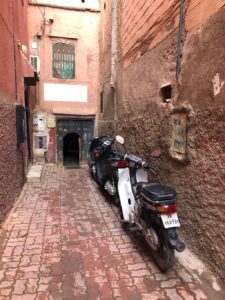 Morocco is a very young country—over 70% of the population is under 35 years of age. Most old men we saw were in front of their shops and old women seemed nonexistent, probably they were cooking at home.
Morocco is a very young country—over 70% of the population is under 35 years of age. Most old men we saw were in front of their shops and old women seemed nonexistent, probably they were cooking at home.
We tried to catch up with the fast carrier, running behind him. The streets were getting narrower and narrower, but the motorcycles managed to make it through. In some cases, we had to lower ourselves to make it under a gate or a city wall, appearing right and left. Finally, the carrier turned into a very narrow and dark passage—Philadelphia’s Elfreth’s Alley would be like a boulevard in Marrakesh—and he stopped in front of an old black door. Our guide knocked three times, but no one came to open. I looked at my daughter Jane—this was her trip to celebrate her fiftieth birthday. She looked shocked, maybe frightened. Our accommodations had been spectacular so far; Villa Mandarine,
a cozy boutique hotel in Rabat and a luxurious palace-like hotel in Fes, the Palais Faraj, fit for a sultan. This spot looked like the ethnic film Ali Zaoua: Prince of the Streets (2000) I watched in preparation for this trip.
After another knock, the door opened and Valeria appeared in a flowing green, silk gown. She looked as beautiful as any of my Spanish cousins, but she is Italian, from Lake Como. Before we could speak, we were sitting in a patio, with exuberant plants around us, gorgeous wicker furniture, a small wading pool, lovely antiques, and we were being served mint tea. This is what Moroccans call a “Riad” or the old house of a rich person turned into a bed and breakfast of sorts.
There were stairs every corner: to a spa area, to a library, to hidden hallways that opened to entire suites like ours with three bedrooms, two baths, and a living room with a fireplace. Dinner was served in the amazing roof terrace, by the pergola, with a view of the majestic High Atlas Mountains.
Each table was set with immaculate table linens, sparkling crystal, green ceramic plates and what looked like antique silverware. The strangest thing was that the cross stich on the tablecloth looked exactly like the needle point I learned as a child, the “Lagartera” stich. It’s hard to tell what came first the Moorish design or the Castilian style.
In fact, the entire trip has been the chicken or the egg story. I thought I was a good student of history growing up in Madrid, but I learned it all from the point-of-view of a Spaniard, while our guide in Morocco didn’t learn it that way. The Berbers, Almoravids, Almohads and particularly Almanzor, were all Moors to us, not heroes. Just about the only thing Mokhtar and I agreed on was the date when the Arabs invaded the Iberian Peninsula all the way up to Covadonga in Asturias; it was 711. Thank goodness that we came to a good resolution of the chicken or the egg with my name; originally “Al borch,” the tower in Arabic, which my grandfather changed to the more European sounding Alborg. I do try to identify with the natives on every trip!
The first lesson I learned from Mokhtar was that people in Morocco are Moroccans, not Africans. Africans are people from sub-Sahara, not from the Maghreb. And what about the Moroccan playing cards? which are the same as the ones in Spain, even counted in Spanish, or the “botijo,” the ceramic water jug, also named in my native language. Even the tagines are similar to our earthen “cazuelas.”
There was an old-fashioned saying that my father didn’t like: “Africa empieza en los Pirineos” (Africa starts at the Pyrenees). I knew better than to repeat it and I’m sorry I brought it up now. Wait a moment, I have the perfect solution: “Spain goes all the way down to the Sahara.”

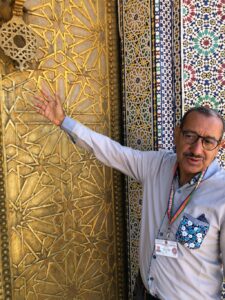
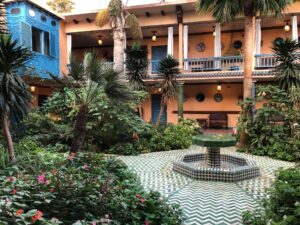


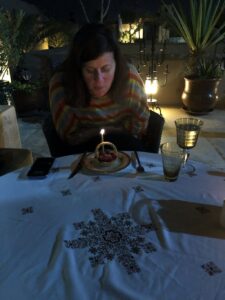
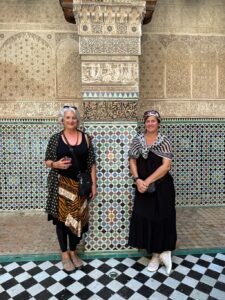
Concha , I LOVE it! “Africa empieza en los Pirineos”? NO!
“Spain goes all the way down to Sahara! 🙂
I took Marrakech Express in 1968 and your description here
brings back fond memories. Thank you
Rosina
Thanks so much, Rosina. You are such a faithful reader!
Concha
This writing brough back fond memories of Maddie’s and my tour of Morocco. Pictures
and the descriptions were vivid. Now I want to go back.
Thanks, Herman
Thanks, Herman. Glad you enjoyed it, Concha
What a beautiful picture of the Alborg girls!
Linda
Una crónica de un viaje envidiable. Y me encantan las fotos
Un abrazo, Inés
Gracias, Inés. Es un lugar único, Concha
Thanks for sharing the magic! Alan
Can’t wait to show you all the photos, Concha
I had just read your piece on Morocco. What an adventure, I can’t wait to talk to you about it!
Joan
Yes, Joan. We must compare notes, Concha
Welcome back Concha! Your pictures are wonderful and it looked like a great trip. I cannot believe you have a 50 yr old daughter though! I recognized several places you were at including the goats in the Argan nut trees! I loved that women operate that industry. I had brought back some pure oil for my coarse hair and it was so effective. I enjoyed reading your blog post earlier today. Johanne
Thanks, Johanne, and I loved Jardin Majorelle (as per your suggestion), Concha